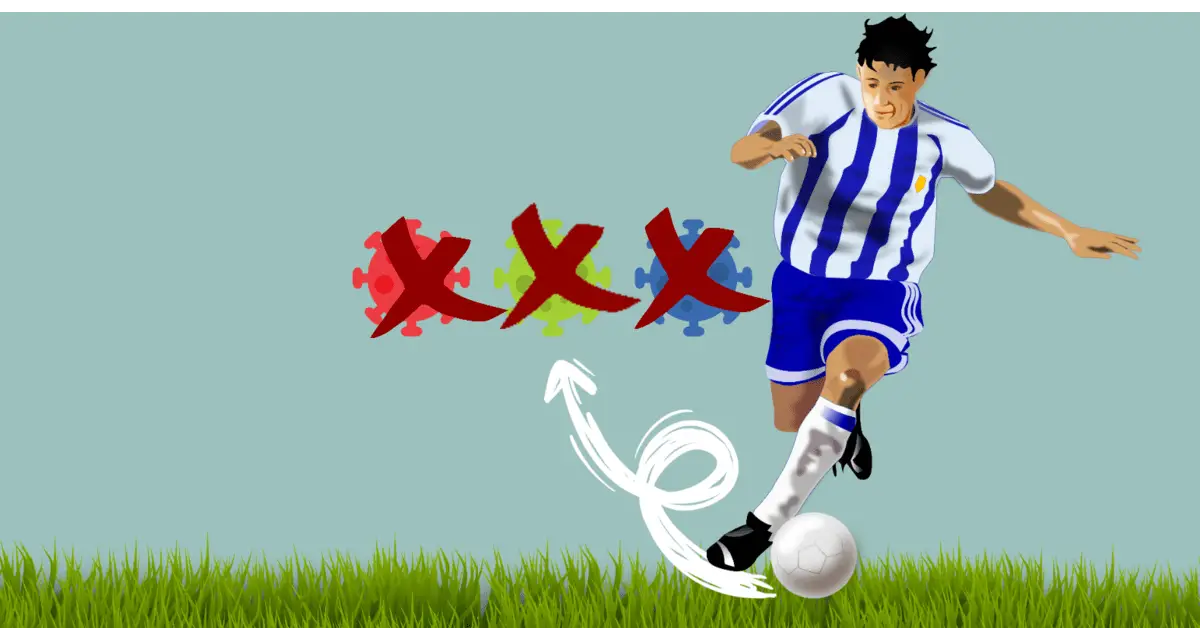Have you ever wondered what happens during a football preseason training program?
The period preceding the start of a football season is a crucial time for top-level clubs, as they lay the foundation for success through intensive preseason training programs.
Football Preseason Training Programs are meticulously designed and executed to enhance players’ physical fitness, tactical understanding, and team cohesion. These behind-the-scenes preparations set the stage for the gruelling challenges that lie ahead and play a vital role in shaping the team’s performance throughout the season.
In this article, we will delve into the world of football preseason training, shedding light on these programs and exploring what it takes to prepare a team for the demanding battles on the pitch.
By understanding the inner workings of these training regimens, we can gain a deeper appreciation for the dedication and meticulous planning that goes into moulding a successful football team.
When does preseason start and end for European teams?
The preseason for European teams typically starts in the summer months, typically between late June and early July, depending on the league and club. The exact start date can vary slightly from year to year and can be influenced by factors such as international tournaments and the specific league schedule.
The preseason period generally lasts for several weeks, usually ranging from 4 to 6 weeks. During this time, teams engage in intensive training sessions, friendly matches, and various preparations to fine-tune their squad ahead of the upcoming season. The preseason culminates with the start of the regular season, which usually begins in August or early September.
It’s important to note that specific dates can vary across different leagues and countries within Europe. Additionally, teams participating in international competitions may have a modified preseason schedule, taking into account their tournament commitments.
Therefore, it is advisable to refer to the official announcements and schedules of individual clubs and leagues for precise information regarding the start and end dates of preseason for European teams.
What is involved in designing a typical Football preseason training program?
Designing a typical preseason training program requires a multifaceted approach that takes into account various factors to maximize the team’s performance. Below here are the key considerations involved in designing such a program.
1. Evaluation of Squad
The coaching staff and medical team assess the squad’s fitness levels and overall condition. This evaluation involves medical assessments, individual player evaluations, and performance metrics analysis. Identifying strengths, weaknesses, and injury risks helps tailor the training program to address specific needs.
2. Training Goals
The training program is designed based on the team’s playing style, strategic objectives, and the coach’s philosophy. It aims to improve physical fitness, enhance tactical understanding, and foster team cohesion. Clear training goals are set to ensure a structured approach to achieving desired outcomes.
3. Individual Player Roles
The training program takes into account the specific roles and positional demands of each player. Different positions require varying levels of endurance, speed, agility, and technical skills. Tailoring exercises and drills to meet these demands optimizes individual player development and overall team performance.
4. Components of the Program
A comprehensive preseason training program consists of multiple components. Physical conditioning focuses on building aerobic and anaerobic endurance, strength, speed, and agility. Tactical training includes drills and exercises to improve tactical understanding, decision-making, and positional awareness. Team bonding activities foster camaraderie and cohesion among players.
5. Periodization and Progression
Preseason training programs follow a periodized approach, gradually increasing intensity and workload over time. This allows players to adapt and progress without risking injury or burnout. The program is divided into phases, with each phase targeting specific objectives and gradually building towards peak fitness levels.
6. Monitoring and Adjustments
Sports science plays a crucial role in monitoring players’ fitness levels and performance throughout the preseason. Key performance indicators and metrics are tracked to evaluate progress and identify areas that require adjustments. This data-driven approach allows coaches and sports scientists to fine-tune the training program for optimal results.
Specific Football Training Program for Preseason
Although preseason training regimes differ from team to team, some sessions are common and quite general irrespective of the team.
Below here are some of the most common preseason training programs for a typical football team.
1. Endurance Training
Endurance training is a fundamental component of preseason preparation. One effective training regime is high-intensity interval training (HIIT).
Players engage in repetitive bursts of intense activity, such as sprinting or shuttle runs, followed by short recovery periods. This challenges the cardiovascular system and improves the body’s ability to sustain high-intensity efforts throughout a match.
It also enhances players’ ability to recover quickly between sprints, crucial for maintaining performance during intense game situations.
Practical Example: Imagine a training session where players perform a series of 30-second sprints, followed by 15 seconds of active recovery (light jogging or walking).
This cycle is repeated multiple times, simulating the intermittent nature of football. The session can be modified by increasing the sprint duration or reducing the recovery time as players’ fitness levels improve.
2. Strength and Power Training
Building strength and power is essential for enhancing overall athletic performance. Resistance training with weights, plyometric exercises, and explosive movements are incorporated into the training regime.
Exercises like squats, lunges, bench presses, and medicine ball throws are utilized to target specific muscle groups and improve muscular strength and power.
Practical Example: A training session might include exercises such as barbell squats, where players perform sets of controlled squats with progressively heavier weights. This challenges the lower body muscles and helps develop leg strength.
Additionally, plyometric exercises like box jumps or depth jumps can be integrated, focusing on explosive power development. These exercises enhance players’ ability to generate force quickly and effectively, improving their jumping and sprinting abilities.
3. Tactical Drills and Small-Sided Games
Preseason training involves tactical drills and small-sided games that simulate real match scenarios. These sessions enhance players’ decision-making, positional awareness, and understanding of team strategies. Tactical drills might include practising defensive positioning, offensive combinations, or set-piece routines.
Small-sided games, such as 5v5 or 7v7, provide a dynamic and intense environment that challenges players’ tactical understanding while encouraging quick thinking and adaptability.
Practical Example: In a tactical training session, players might work on defensive organization. They practice maintaining compactness, pressing the opposition, and executing defensive transitions.
Coaches provide specific scenarios, simulating different game situations and encouraging players to make quick decisions based on their understanding of team tactics.
4. Team Building and Communication Exercises
Preseason training is an ideal time to foster team bonding and communication. Activities that encourage trust, cooperation, and effective communication are integrated into the program.
These exercises enhance players’ understanding of each other’s strengths, improve team chemistry, and promote a cohesive and supportive team environment.
Practical Example: A team-building session might involve problem-solving activities where players must work together to overcome challenges or obstacles.
This could include team-building exercises such as blindfolded trust walks, where players guide and support each other through a predetermined course, relying on effective communication and trust. These activities strengthen relationships and improve on-field communication, leading to improved teamwork during matches.
Periodization and Progression in Football Preseason Training Program
Periodization is a systematic approach to training that involves dividing the preseason into distinct phases, each with specific training objectives. It allows for structured progression and optimal adaptation to enhance performance. Different phases focus on building different aspects such as endurance, strength, and tactical understanding. This ensures that players peak at the right time, ready for the start of the season.
Gradual progression of training intensity and workload is essential during the preseason. It involves incrementally increasing the demands placed on players’ bodies and minds.
Training sessions start with lower intensity and gradually intensify as players improve their fitness levels. This progression allows players to adapt, minimize the risk of injury, and optimize performance gains.
Rest and recovery periods are crucial within the preseason training schedule. These periods provide players with the opportunity to recuperate, regenerate, and adapt to the physical and mental demands of training.
Adequate rest and recovery reduce the risk of overtraining and help prevent injuries. They also enable players to maintain high levels of performance throughout the season.
Monitoring and Adjustments in the Football Preseason Training Program
Players’ fitness levels and performance are monitored through various methods. This includes regular physical assessments such as fitness tests, body composition analysis, and monitoring of vital signs.
Additionally, tracking performance data using wearable technology and tracking systems provides objective information on players’ workloads, distances covered, and physiological markers.
Sports science plays a vital role in monitoring key performance indicators and metrics during the preseason.
Sports scientists analyze data such as sprint times, heart rate variability, and muscle fatigue markers to assess players’ readiness and recovery. These indicators help identify areas of improvement and potential injury risks, allowing for targeted interventions.
Training programs are adjusted based on individual and collective performance. Data analysis and feedback from the coaching staff and sports scientists inform decision-making.
Adjustments can include modifying training loads, exercise selection, and recovery strategies. Individualized attention may be given to players who require specific focus, such as those recovering from injuries or with unique training needs.
Final Thought
The Football Preseason Training Program is a critical phase for top-level football clubs in their pursuit of success. Through periodization and progression, the training program is carefully designed to optimize players’ physical and mental development, ensuring peak performance at the start of the season.
Monitoring and adjustments, facilitated by sports science, provide valuable insights into players’ fitness levels and performance, leading to tailored interventions for individual and collective improvement.
The incorporation of rest and recovery periods is essential for players’ overall well-being and injury prevention. By embracing these principles, clubs can lay a solid foundation for the gruelling challenges that lie ahead, setting the stage for a successful and competitive season.
The Football Preseason Training Program serves as a testament to the dedication, meticulous planning, and scientific approach that underpin the behind-the-scenes efforts in football.





